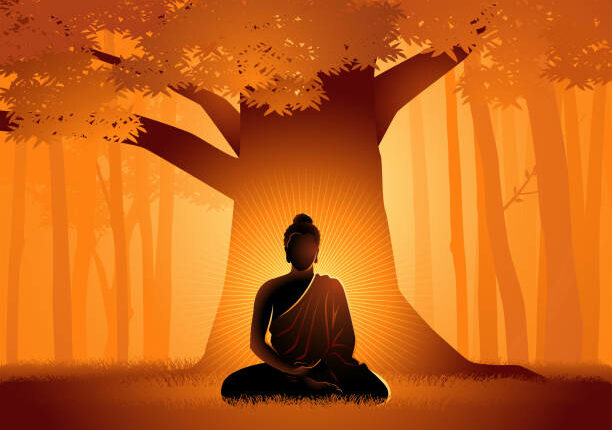NOBLE EIGHTFOLD PATH
The Noble Eightfold Path is an early summary of the path of Buddhist practices. It can lead you to liberation from samsara, the painful cycle of rebirth, in the form of nirvana.
In early Buddhism, these practices started with the understanding that the body-mind works in a corrupted way followed by entering the Buddhist path of self-observance, self-restraint, and cultivating kindness and compassion; and culminating in ‘dhyana’ or samadhi, which reinforces these practices for the development of the body-mind.
In later Buddhism, the “goal” of the Buddhist path came to be specified as ending ignorance and rebirth.
The Eightfold Path consists of eight practices: right view, right resolve, right speech, right conduct, right livelihood, right effort, right mindfulness, and right samadhi.
In Buddhist symbolism, the Noble Eightfold Path is often represented by the dharma wheel (dharmachakra), whose eight spokes represent the eight elements of the path.
The eight Buddhist practices in the Noble Eightfold Path are:
Right View:
our actions have consequences, death is not the end, and our actions and beliefs have consequences after death. The Buddha followed and taught a successful path out of this world and the other world (heaven and hell). Later on, the right view came to explicitly include karma and rebirth, and the importance of the Four Noble Truths, when “insight” became central to Buddhist soteriology.
Right Resolve or Intention:
The giving up of home and adopting the life of a religious mendicant in order to follow the path; this concept aims at peaceful renunciation, into an environment of non-sensuality, non-ill-will (to loving kindness), away from cruelty (to compassion). Such an environment aids contemplation of impermanence, suffering, and non – self.
Right Speech:
No lying, no rude speech, no telling one person what another says about him to cause discord or harm their relationship.
Right Conduct or Action:
no killing or injuring, no taking what is not given, no sexual misconduct, no material desires.
Right Livelihood:
No trading in weapons, living beings, meat, liquor, and poisons.
Right Effort:
Preventing the arising of unwholesome states, and generating wholesome states, the bojjhagā (Seven Factors of Awakening). This includes indriya-samvara, “guarding the sense-doors”, restraint of the sense faculties.
Right Mindfulness (Satipatthana):
A quality that guards or watches over the mind; the stronger it becomes, the weaker unwholesome states of mind become, weakening their power to take over and dominate thought, word and deed. In the Vipassana movement, sati is interpreted as “bare attention”: never be absent minded, being conscious of what one is doing; this encourages the awareness of the impermanence of body, feeling and mind.
Right samadhi:
Practicing four stages of dhyana (“meditation”), which includes samadhi proper in the second stage, and reinforces the development of the bojjhaga culminating into upekkha (equanimity) and mindfulness. In the Theravada tradition and the vipassana movement, this is interpreted as ekaggata, concentration or one-pointedness of the mind, and supplemented with vipassana meditation, which aims at insight.
The Noble Eightfold Path, in Buddhist traditions, is the direct means to nirvana and brings a release from the cycle of life and death in the realms of samsara.

